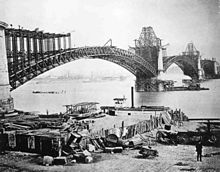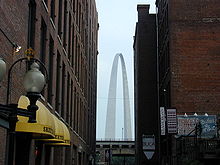St. Louis
![]()
This article is about the city in the USA. For other meanings, see Saint-Louis.
St. Louis (spelled Saint Louis) [ˌseɪntˈluːɪs] is a city in the U.S. state of Missouri on the west bank of the Mississippi River. It has a population of 319,294 (2010 census).
The city is home to several major institutions of higher learning, including Washington University, Saint Louis University, and the University of Missouri-St. Louis. The city used to be a major railroad hub; however, passenger service no longer plays a role. East St. Louis is home to two Illinois State Railroad yards on the east bank of the Mississippi River.
Saint Louis also goes by the nicknames The Gateway City and Mound City, as well as the scene names made famous by local rapper Nelly, The Lou and Nellyville.
In 2006, St. Louis topped the list of the most dangerous cities in the United States because they only included the numbers for downtown and not the numbers for the entire metro area as well. From 2014 to 2016, St. Louis again topped the list of cities with the most homicides in the United States. This ranked St. Louis 15th in the world (2015). The statistics still listed Baltimore, Detroit and New Orleans as the most dangerous cities in the United States.
The Greater St. Louis metropolitan region has a total population of 2.8 million. The region is thus the eighteenth largest metropolitan area in the United States (as of 2010). However, the metropolitan area is not part of St. Louis County, which is home to 998,954 people.

Gateway Arch
.jpg)
Missouri Botanical Garden

Construction of the Eads Bridge over the Mississippi River before 1874

Gateway Arch
History
Pre-Colonial
About ten kilometres east of today's city centre, on the then course of the Mississippi, lay the largest city of pre-Columbian North America: probably founded in the 7th century, Cahokia, a centre of the Mississippi culture, reached a population in the 12th century for which estimates range from about 8000 to as high as 40,000. This made Cahokia the largest city ever built north of present-day Mexico; only around 1800 did Philadelphia reach such a population. The city was famous for its earth pyramids (mounds), similar to those of the Central American advanced civilizations; the largest extant, Monks Mound has side lengths greater than the pyramids of Giza. The city was abandoned by its inhabitants around 1400 for unknown reasons. When the first Europeans reached the area in the 17th century, they found the settlement site abandoned. The site of Cahokia has been a UNESCO World Heritage Site since 1982.
18th century: Colonization, founding of cities
French merchant Pierre Laclède Liguest and his New Orleans-born stepson Auguste Chouteau founded Saint Louis in 1763 as a trading post. The actual founding of the city took place on February 15, 1764. After the French and Indian War (1754-1763), Saint Louis was under Spanish control, but was returned to France - along with the rest of Louisiana - during the Napoleonic War.
19th century: Part of the United States from 1803
The United States acquired the city in 1803 under President Thomas Jefferson as part of the Louisiana Purchase. Later, Saint Louis became the starting point for many expeditions to the West such as the Lewis and Clark expedition as well as for fur hunters. Many settlers also started west from Saint Louis.
During the War of Secession, the town became the site of the Camp Jackson Massacre in 1861.
At that time, St. Louis had ranked fourth among U.S. cities with a population of 310,000, after New York, Brooklyn (then still independent), and Philadelphia. Chicago, however, was able to prove that St. Louis had added 90,000 residents who did not live in the immediate metropolitan area. Even at the turn of the 20th century, the Gateway City was predicted to have a bright future due to its favorable location as a gateway to the West.
In the 19th century, a strong influx of German immigrants to Saint Louis had begun. In 1860, Germans made up about 60,000 of Saint Louis' population of about 170,000. The large Anheuser-Busch brewery was founded in 1870 by Eberhard Anheuser of Bad Kreuznach and his son-in-law Adolphus Busch of Mainz-Kastel. For the German Catholic community, the church of St. Frances de Sales was built between 1895 and 1908 according to the designs of the Berlin architect Engelbert Seibertz. St. Louis Place Park was decorated on November 13, 1898, after three days of festivities, with a copy of the statue of Schiller from Marbach am Neckar, created by Ernst Rau in 1876. This donation was made by the brewmaster Col. Charles Stifel. The Schiller statue was later moved to Memorial Plaza near City Hall, where it still stands today.
20th century: heyday until 1950, then decline
In 1904, St. Louis hosted both the Olympic Games and the Louisiana Purchase Exposition, the world's fair that ran from April 30 to December 1.
St. Louis reached its largest population in the 1950 census at 856,796. Since then, the population has been steadily declining. The exodus from downtown to the surrounding countryside is particularly noticeable in the area around St. Louis Place Park and around the once fashionable St. Louis Avenue, where horse-drawn trams ran as early as 1875. Complete historic blocks of houses there have been demolished since the 1950s or, largely as neglected ruins, bear witness to the former handsome splendor of this neighborhood, which had been on the rise since the 1880s and was especially popular with German immigrants. Here there were German congregations of all denominations and schools where instruction was given in German.
21st century
Even in 2010, St. Louis may not have reached its population nadir with a counted population of 319,294; according to one estimate, its population has continued to shrink since then. The city today has a demographic plurality of African Americans (47.1%). The urban area is uninviting for residential purposes, compared to the well-developing suburban communities. To the east on the Mississippi River bank, the industrial and commercial zone stretches for about 15 kilometers, interrupted only by Jefferson Memorial Park with the Gateway Arch. This partly run-down area closes the citizens' access to the riverbank. Downtown is crisscrossed in its center by railroads and elevated highways and occupied by large sports venues, shopping malls, and huge parking lots. In the residential areas close to the city center in the north and south, abandoned house lots have been partially cleared and converted into small green spaces, so that the city can now boast over a thousand parks.
Flag
The St. Louis flag was developed by Theodore Sizer (Yale University) and officially adopted in 1964. It symbolizes the confluence of the Mississippi and Missouri rivers near St. Louis. The intersection of the blue lines falls under a French lily (fleur-de-lis), symbolizing the city's French heritage. In a survey conducted in 2004 on the North American Vexillological Association website, the flag ranked fifth among American city flags.
Search within the encyclopedia